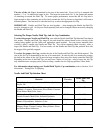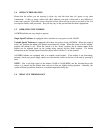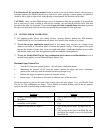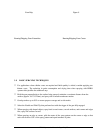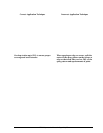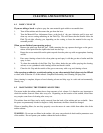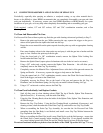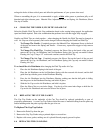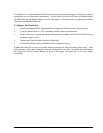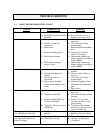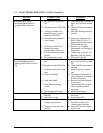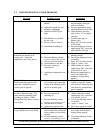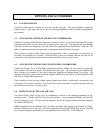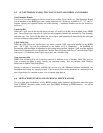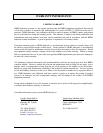
HERO Operator’s Manual – Page 20 of 23
5.2 TROUBLESHOOTING FINISH PROBLEMS
Problem Probable Cause Solution(s)
Runs or Sags A. Coating has been over-
diluted
B. Application speed too slow
C. Improper overlapping
D. Needle and Fluid Tip too
large
E. Film thickness is too thick
for one coat
F. Gun too close to surface
G. Insufficient atomizing air
A. Add undiluted material and
mix thoroughly; flush gun
with new mixture
B. Increase application speed
C. Overlap passes by up to 50%
D. Check material viscosity;
refer to Sec. 3.3 for proper
selection
E. Consider spraying too
thinner coats
F. Spray 6-8” from the surface
to be coated
G. Increase turbine air volume
output using VSC; experiment
with different Air Caps
“Orange Peel”:
Finish has the texture of an
orange peel. A dimpled
appearance, often very glossy.
A. Insufficient dilution
B. Incorrect thinning solvent:
solvent is evaporating too fast
C. Gun too far from surface
D. Film thickness is too thin
E. Incorrect amount of
atomizing air
F. Ambient air temperature too
high
A. Check viscosity; add
thinning solvent
B. Use slower thinning solvent
or retarder
C. Spray 6-8” from the surface
D. Apply a “wetter” coat
E. Adjust turbine air volume
output using VSC; experiment
with different Air Caps
F. Reduce air temperature in
spray area and/or add
retarder to coating being
applied
“Fish Eyes”:
Small round depressions in the
paint film. Normally form as
soon as part is sprayed.
A. Contaminant on the surface
(oil, moisture) preventing the
coating from adhering to the
surface in certain spots
A. Very difficult to correct once
surface is sprayed. Ensure
that surface is clean, dry and
free from any contaminants
prior to spraying
“Dry Spray”:
Surface is dull and rough. Dry
paint particles protruding from,
or sitting on surface. Unlike
Orange Peel, Dry Spray is always
low in gloss.
A. Gun too far from surface
B. Incorrect amount of
atomizing air
C. Incorrect thinning solvent:
solvent is evaporating too fast
D. Film thickness is too thin
E. Application speed too fast
A. Spray 6-8” from the surface
B. Adjust turbine air volume
output using VSC; experiment
with different Air Caps
C. Use slower thinning solvent
or retarder
D. Apply a “wetter” coat
E. Slow down speed of motion
“Blushing”:
Large whitish areas in the finish
A. High humidity in the spray
area: moisture has condensed
in the coating as it was being
sprayed.
B. Incorrect thinning solvent:
solvent is evaporating too fast
A. Reduce humidity in spray
area and/or add retarder to
coating being sprayed
B. Use slower thinning solvent
or retarder
For all other problems, please contact your local HERO distributor or HERO directly



